

"We don't know what we don't know" - So what can we do about it? In my work I often hear the following...

We don't know what we don't know Seems fair enough, right? I always thought so, but recently (after hearing it a lot) I've really be pondering this statement and am starting to wonder if it could, sometimes, just be an excuse. 15 Expert Google Drive Tips for Teachers. By Jessica Sanders Google Drive makes your life easier and encourages collaboration and 21st century skill development among your students.

Make sure you’re getting the most of out this free tool with these expert tips. 1. New ways to share in Google Drive and Classroom. Posted by George Reis, Software Engineer As more and more schools have started using Drive and Classroom, you’ve given us a ton of ideas about ways these tools can help you get more done, especially when it comes to who can share what within your school.
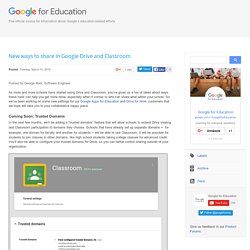
So we’ve been working on some new settings for our Google Apps for Education and Drive for Work customers that we hope will take you to your collaborative happy place. Coming Soon: Trusted Domains In the next few months, we’ll be adding a “trusted domains” feature that will allow schools to extend Drive sharing and Classroom participation to domains they choose. Schools that have already set up separate domains – for example, one domain for faculty and another for students – will be able to use Classroom. 15 Tech Skills to Learn This Summer. By Whooo’s Reading Blog Team Summer is a time to relax, enjoy the sunshine… and prepare for next year.
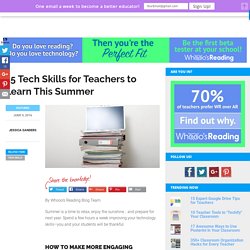
Spend a few hours a week improving your technology skills—you and your students will be thankful. How to make more engaging presentations. With so many digital tools at your fingertips, there’s no excuse for a snoozefest presentation. Student Letters Deliver Heightened Engagement. Before each school year begins, I indulge in a back-to-school teacher movie marathon for motivation.
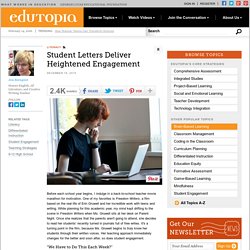
One of my favorites is Freedom Writers, a film based on the real life of Erin Gruwell and her incredible work with teens and writing. While planning for this academic year, my mind kept drifting to the scene in Freedom Writers when Ms. Gruwell sits at her desk on Parent Night. Buildingdigitalcitizens - home. 6 Alternatives To Bloom's Taxonomy For Teachers - This post is updated from an article we published in April.

At the end of the day, teaching is about learning, and learning is about understanding. How to use search like a pro: 10 tips and tricks for Google and beyond. Search engines are pretty good at finding what you’re looking for these days, but sometimes they still come up short.
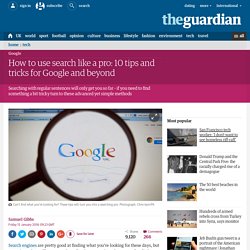
For those occasions there are a few little known tricks which come in handy. So here are some tips for better googling (as it’s the most popular search engine) but many will work on other search engines too. 1. Exact phrase The simplest and most effective way to search for something specific is to use quote marks around a phrase or name to search for those exact words in that exact order. For instance, searching for Joe Bloggs will show results with both Joe and Bloggs but not necessarily placed sequentially. The exact or explicit phrase search is very useful for excluding more common but less relevant results. 2.
If exact phrase doesn’t get you what you need, you can specifically exclude certain words using the minus symbol. A search for “Joe Bloggs” -jeans will find results for Joe Bloggs, but it will exclude those results for the Joe Bloggs brand of jeans. 3. 4. 5. 6. 7. Education Research Highlights From 2015. 2015 was a great year for education research. fMRI technology gave us new insight into how exercise can improve math ability by changing the structure of children's brains (#13 below).

The Quo Has Lost its Status - Home. Listening to student voice… Enthusiastic students from Years 4, 5 and 6 sit in a circle at the end of the day and share reflections on our Program of Inquiry.
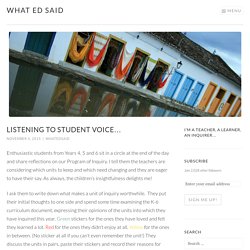
I tell them the teachers are considering which units to keep and which need changing and they are eager to have their say. As always, the children’s insightfulness delights me! I ask them to write down what makes a unit of inquiry worthwhile. They put their initial thoughts to one side and spend some time examining the K-6 curriculum document, expressing their opinions of the units into which they have inquired this year. Green stickers for the ones they have loved and felt they learned a lot. Quit Blaming the Devices.
Her biggest issue, though, was with the silence.
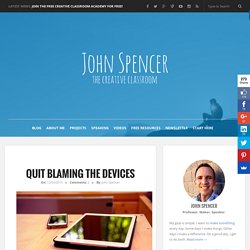
As she puts it, “My lively little kids stopped talking and adopted the bent-neck, plugged-in posture of tap, tap, swipe.” Imagine the same complaint with a book. "My lively kids stopped talking and adopted the bent-necked, lost in a book posture of scanning text and flipping pages. " Kids stopped talking and started reading. Musings from the Middle School: Practicing What You Pin: Textmapping. Have you ever heard of textmapping? So, a long time ago, I pinned an image that led me to this site. I spent a while exploring all the awesome information here and couldn't wait to try it in my classroom!
How to Manage Homework without Going Crazy. Homework – the kids probably think we teachers take some sadistic pleasure in giving homework, but the reality is that homework is a huge pain. It’s lots of extra work to track and grade. And it’s especially frustrating when students just aren’t doing it – or just throwing down any answer without trying. I’m not so sure that there are any cure-all answers to the homework dilemma, but over the years I’ve come up with some solutions that have ended up working fairly well for me. Calling All Learners and Teachers for Hour of Code 2015. Chances are high that computer-science literacy will be increasingly relevant for jobs of the future. Some theorists even suggest that the ability to read and write code is a fundamental 21st-century competency.
Yet, according to an August 2015 Gallup survey, many students get little exposure to these concepts at school; opportunities are even more limited for low-income students. To address these realities, there are a variety of free resources that can help teachers of all grades and subjects give students exposure to computer science, as well as access to opportunities that develop the skills required to approach coding problems. This December 7-13, 2015, the Hour of Code campaign during Computer Science Education Week is one such opportunity. Teaching Strategy: Identity Charts. Rationale Identity charts are a graphic tool that helps students consider the many factors that shape who we are as individuals and as communities.
They can be used to deepen students’ understanding of themselves, groups, nations and historical and literary figures. Sharing their own Identity charts with peers can help students build relationships and breakdown stereotypes. In this way, identity charts can be utilized as an effective classroom community-building tool. Procedure Step one: Preparation Before creating identity charts, you might have the class brainstorm categories we consider when thinking about the question, “Who am I?” Step two: Create identity charts for a historical or literary figure, group or nation First, ask students to write the name of the character, figure, group or nation in the center of a piece of paper. Step three: Use identity charts to track new learning Variations Notice the words inside and outside of your hand outline. Universal Design for Learning. Learners differ significantly in the ways they can be engaged or motivated to learn. Some learners are highly engaged and motivated by spontaneity and novelty, while others are disengaged, even frightened by those aspects, preferring a predictable routine.
Hapara Teacher Dashboard and Google Apps / Snapshots of Learning / Teaching. Getting Good with Google. 5 Strategies to Help You Rethink Research. Research Meets Gamification With A Google A Day. A Google a Day. Research Meets Gamification With A Google A Day.